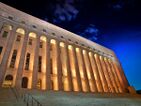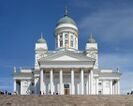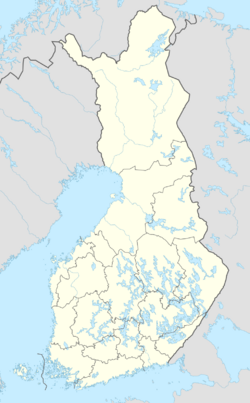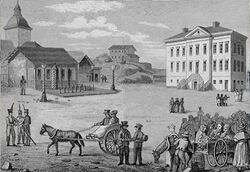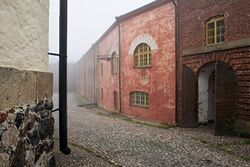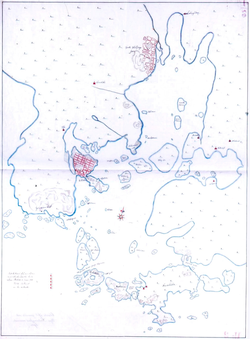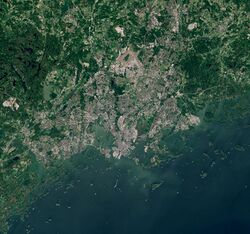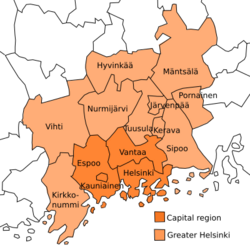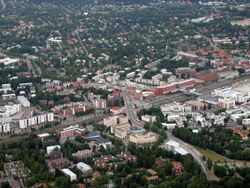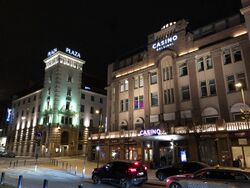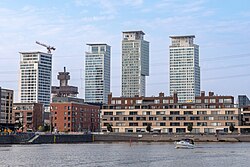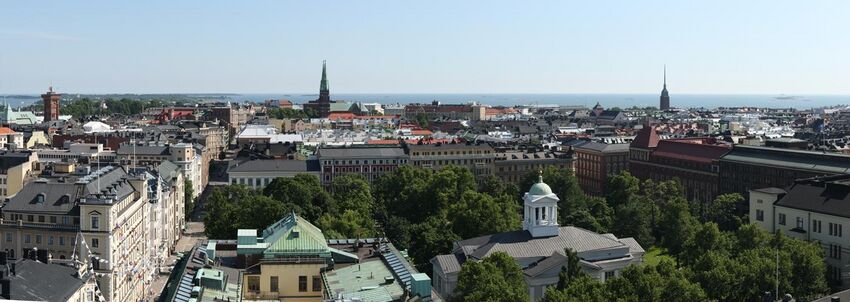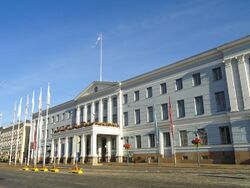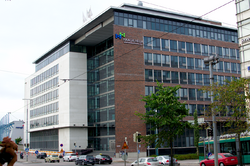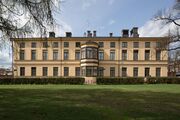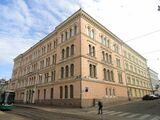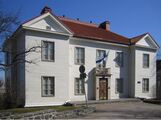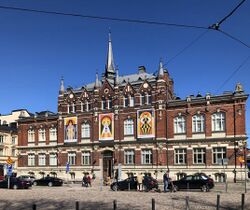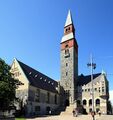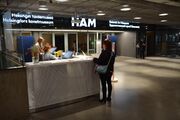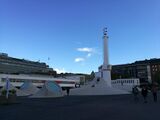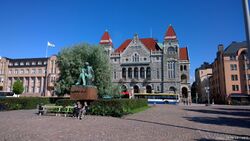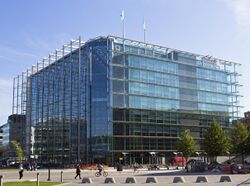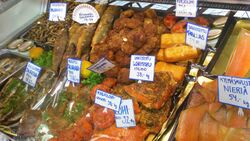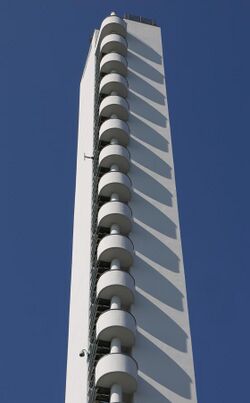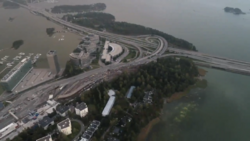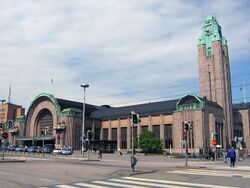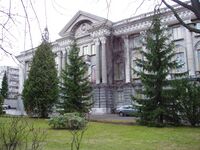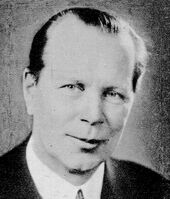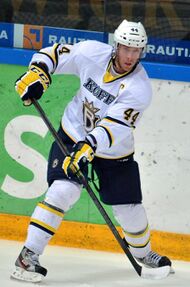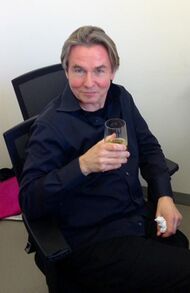Helsinki
Topic: Place
 From HandWiki - Reading time: 44 min
From HandWiki - Reading time: 44 min
Helsinki Helsingfors (Swedish) | |
|---|---|
Capital city | |
| Helsingin kaupunki Helsingfors stad City of Helsinki | |
View of central Helsinki along the Mannerheimintie Suomenlinna Sanoma building and Kiasma Parliament House Helsinki Cathedral Beaches at Aurinkolahti | |
| Nicknames: | |
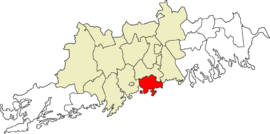 Location (in red) within the Uusimaa region and the Greater Helsinki sub-region (in yellow) | |
| Coordinates: [ ⚑ ] : 60°10′15″N 24°56′15″E / 60.17083°N 24.9375°E | |
| Country | |
| Region | |
| Sub-region | Greater Helsinki |
| Charter | 12 June 1550 |
| Capital city | 8 April 1812 |
| Government | |
| • Mayor | Juhana Vartiainen (KOK) |
| • Governing body | City Council of Helsinki |
| Area | |
| • Capital city | Template:Data Finland municipality km2 (Formatting error: invalid input when rounding sq mi) |
| • Land | Template:Data Finland municipality km2 (Formatting error: invalid input when rounding sq mi) |
| • Water | Template:Data Finland municipality km2 (Formatting error: invalid input when rounding sq mi) |
| • Urban | 680.12 km2 (262.60 sq mi) |
| • Metro | Expression error: Unrecognized punctuation character "[". km2 (Formatting error: invalid input when rounding sq mi) |
| Elevation | 26 m (85 ft) |
| Population | |
| • Capital city | Template:Data Finland municipality |
| • Rank | Template:Data Finland municipality |
| • Urban | 1,360,075 |
| • Urban density | 2,000/km2 (5,200/sq mi) |
| • Metro | Expression error: Unrecognized punctuation character "[". (Greater Helsinki) |
| Demonym(s) | helsinkiläinen (Finnish) helsingforsare (Swedish) Helsinkian (English) |
| Template:Data Finland municipality | |
| • Template:Data Finland municipality | Template:Data Finland municipality |
| • Template:Data Finland municipality | Template:Data Finland municipality (official) |
| • Template:Data Finland municipality | Template:Data Finland municipality |
| • Template:Data Finland municipality | Template:Data Finland municipality |
| Template:Data Finland municipality | |
| • Template:Data Finland municipality | Template:Data Finland municipality |
| • Template:Data Finland municipality | Template:Data Finland municipality |
| • Template:Data Finland municipality | Template:Data Finland municipality |
| Time zone | UTC+02:00 (EET) |
| • Summer (DST) | UTC+03:00 (EEST) |
| Area code(s) | +358-9 |
| Template:Data Finland municipality | Template:Data Finland municipality |
| Climate | Dfb |
| Website | www |
Helsinki (/ˈhɛlsɪŋki/ HEL-sink-ee or /hɛlˈsɪŋki/ (![]() listen) hel-SINK-ee;[5][6] Finnish: [ˈhelsiŋki] (
listen) hel-SINK-ee;[5][6] Finnish: [ˈhelsiŋki] (![]() listen); Swedish: Helsingfors, sv-FI) is the capital, largest and most populous city in Finland . Located on the shore of the Gulf of Finland, it is the seat of the Uusimaa region in southern Finland and has a population of Template:Data Finland municipality/population count.[7] The city's urban area has a population of 1,360,075,[8] making it by far the most populous urban area in Finland and the country's most important centre for politics, education, finance, culture and research. Helsinki is located 80 kilometres (50 mi) north of Tallinn, Estonia, 400 km (250 mi) east of Stockholm, Sweden, and 300 km (190 mi) west of Saint Petersburg, Russia. It has close historical links with these three cities.
listen); Swedish: Helsingfors, sv-FI) is the capital, largest and most populous city in Finland . Located on the shore of the Gulf of Finland, it is the seat of the Uusimaa region in southern Finland and has a population of Template:Data Finland municipality/population count.[7] The city's urban area has a population of 1,360,075,[8] making it by far the most populous urban area in Finland and the country's most important centre for politics, education, finance, culture and research. Helsinki is located 80 kilometres (50 mi) north of Tallinn, Estonia, 400 km (250 mi) east of Stockholm, Sweden, and 300 km (190 mi) west of Saint Petersburg, Russia. It has close historical links with these three cities.
Together with the cities of Espoo, Vantaa and Kauniainen – and surrounding commuter towns,[9] including the neighbouring municipality of Sipoo to the east[10] – Helsinki forms the Greater Helsinki Metropolitan Area. It has a population of 1,641,329. Often considered Finland's only metropolis, it is the world's northernmost metropolitan area with over one million inhabitants and the northernmost capital of an EU member state. Helsinki is the third largest municipality in the Nordic countries after Stockholm and Oslo, and its urban area is the second largest in the Nordic countries after Stockholm. The official languages are Finnish and Swedish. The city is served by Helsinki Airport, located in the neighbouring city of Vantaa, with frequent flights to many destinations in Europe, North America and Asia.
Helsinki hosted the 1952 Summer Olympics, the first CSCE/OSCE Summit in 1975, the 52nd Eurovision Song Contest in 2007 and it was the 2012 World Design Capital.[11]
Helsinki has one of the highest standards of urban living in the world. In 2011, the British magazine Monocle ranked Helsinki as the world's most liveable city in its liveable cities index.[12] In the Economist Intelligence Unit's 2016 liveability survey, Helsinki ranked ninth out of 140 cities.[13] In July 2021, the American magazine Time (magazine) named Helsinki as one of the world's greatest places in 2021, as a city that "can grow into a burgeoning cultural nest in the future" and that is already known as an environmental pioneer in the world.[14] In an international Cities of Choice survey conducted in 2021 by the Boston Consulting Group and the BCG Henderson Institute, Helsinki was ranked the third best city in the world to live in, with London and New York City coming in first and second.[15][16] In the Condé Nast Traveler magazine's 2023 Readers' Choice Awards, Helsinki was ranked 4th as the friendliest cities in Europe.[17] Helsinki, along with Rovaniemi in Lapland, is also one of Finland's most important tourist cities.[18] Due to the large number of sea passengers per year, Helsinki is classified as a major port city.[19]
Etymology
According to a theory put forward in the 1630s, at the time of Swedish colonisation of the Finnish coast, colonists from Hälsingland in central Sweden arrived at what is now the Vantaa River and called it Helsingå ('Helsinge River'), giving rise to the names of the village and church of Helsinge in the 1300s.[20] This theory is questionable, as dialect research suggests that the settlers came from Uppland and the surrounding areas.[21] Others have suggested that the name derives from the Swedish word helsing, an archaic form of the word hals ('neck'), which refers to the narrowest part of a river, the rapids.[22] Other Scandinavian towns in similar geographical locations were given similar names at the time, such as Helsingør in Denmark and Helsingborg in Sweden.
When a town was founded in the village of Forsby (later Koskela) in 1548, it was called Helsinge fors, 'Helsinge rapids'. The name refers to the Vanhankaupunginkoski (fi) rapids at the mouth of the river.[23] The town was commonly known as Helsinge or Helsing, from which the modern Finnish name is derived.[24]
Official Finnish government documents and Finnish language newspapers have used the name Helsinki since 1819, when the Senate of Finland moved to the city from Turku, the former capital of Finland. Decrees issued in Helsinki were dated with Helsinki as the place of issue. This is how the form Helsinki came to be used in written Finnish.[25] As part of the Grand Duchy of Finland in the Russian Empire, Helsinki was known in Russian as Script error: The function "transl" does not exist. (Гельсингфорс).
In Helsinki slang, the city is called Stadi (from the Swedish word stad, meaning 'city'). Abbreviated form Hesa is equally common, but its use is associated with people of rural origin ("junantuomat", lit. "brought by a train") and frowned upon by locals.[1][26] Helsset is the Northern Sami name for Helsinki.[27]
History
Early history
After the end of the Ice Age and the retreat of the ice sheet, the first settlers arrived in the Helsinki area around 5000 BC. Their presence has been documented by archaeologists in Vantaa, Pitäjänmäki and Kaarela.[28] Permanent settlements did not appear until the beginning of the 1st millennium AD, during the Iron Age, when the area was inhabited by the Tavastians. They used the area for fishing and hunting, but due to the lack of archaeological finds it is difficult to say how extensive their settlements were. Pollen analysis has shown that there were agricultural settlements in the area in the 10th century, and surviving historical records from the 14th century describe Tavastian settlements in the area.[29]
The early settlements were raided by Vikings and later colonised by Christians from Sweden. They came mainly from the Swedish coastal regions of Norrland and Hälsingland, and their migration intensified around 1100.[28] Swedes permanently colonised the Helsinki region's coastline in the late 13th century after the successful Second Crusade to Finland, which led to the defeat of the Tavastians.[30][29]
Written chronicles from 1417 mention the village of Koskela near the rapids at the mouth of the River Vantaa, where Helsinki was to be founded.[28]
Founding of Helsinki
Helsinki was founded by King Gustav I of Sweden on 12 June 1550 as a trading town called Helsingfors, which he intended to be a rival to the Hanseatic city of Reval (now Tallinn) on the southern shore of the Gulf of Finland.[31][28] In order to populate the newly founded town at the mouth of the Vantaa River, the king ordered the bourgeoisie of Porvoo, Ekenäs, Rauma and Ulvila to move to the town.[32] The shallowness of the bay did not allow for the construction of a harbour, and the king allowed the settlers to leave the unfortunate location. In 1640, Count Per Brahe the Younger, together with some descendants of the original settlers, moved the centre of the town to the Vironniemi peninsula by the sea, today's Kruununhaka district, where the Senate Square and Helsinki Cathedral are located today.[33]
During the second half of the 17th century, Helsinki, as a wooden town, suffered from regular fires, and by the beginning of the 18th century the population had fallen below 1,700. For a long time, Helsinki was mainly a small administrative town for the governors of Nyland and Tavastehus County, but its importance began to grow when a more solid naval defence began to be built in front of the town in the 18th century.[32] Little came of the plans, however, as Helsinki remained a small town plagued by poverty, wars and disease. The plague of 1710 killed most of Helsinki's population.[31] After the Russians conquered Helsinki in May 1713 during the Great Northern War, the retreating Swedish administration set fire to parts of the town.[34][35] Despite this, the town's population grew to 3,000 by the beginning of the 19th century.[28] The construction of the naval fortress of Sveaborg (Viapori in Finnish, now also called Suomenlinna) in the 18th century helped improve Helsinki's status. However, it wasn't until Russia defeated Sweden in the Finnish War and annexed Finland as the autonomous Grand Duchy of Finland in 1809 that the town began to develop into a substantial city. The Russians besieged the Sveaborg fortress during the war, and about a quarter of the town was destroyed in a fire in 1808.[36]
Emperor Alexander I of Russia moved the Finnish capital from Turku to Helsinki on 8 April 1812 to reduce Swedish influence in Finland and to bring the capital closer to St Petersburg.[37][38][39] Following the Great Fire of Turku in 1827, the Royal Academy of Turku, the only university in the country at the time, was also moved to Helsinki and eventually became the modern University of Helsinki. The move consolidated the city's new role and helped set it on a path of continuous growth. This transformation is most evident in the city centre, which was rebuilt in the neoclassical style to resemble Saint Petersburg, largely according to a plan by the German-born architect C. L. Engel. As elsewhere, technological advances such as railways and industrialisation were key factors in the city's growth.
Twentieth century
By the 1910s, the population of Helsinki was already over 100,000, and despite the tumultuous nature of Finnish history in the first half of the 20th century, Helsinki continued to grow steadily. This included the Finnish Civil War and the Winter War, both of which left their mark on the city. At the beginning of the 20th century, there were roughly equal numbers of Finnish and Swedish speakers in Helsinki; the majority of workers were Finnish-speaking. The local Helsinki slang (or stadin slangi) developed among Finnish children and young people from the 1890s as a mixed Finnish-Swedish language, with influences from German and Russian, and from the 1950s the slang began to become more Finnish.[40] A landmark event was the 1952 Olympic Games, which were held in Helsinki. Finland's rapid urbanisation in the 1970s, which occurred late compared to the rest of Europe, tripled the population of the metropolitan area, and the Helsinki Metro subway system was built. Helsinki's relatively low population density and peculiar structure have often been attributed to its late growth.[citation needed]
Geography
Known as the "Daughter of the Baltic"[2] or the "Pearl of the Baltic",[3][41] Helsinki is located at the tip of a peninsula and on 315 islands. The city centre is located on a southern peninsula, Helsinginniemi ("Cape of Helsinki"), which is rarely referred to by its actual name, Vironniemi ("Cape of Estonia"). Population density is comparatively high in certain parts of downtown Helsinki, reaching 16,494 inhabitants per square kilometre (42,720/sq mi) in the district of Kallio, but overall Helsinki's population density of 3,113 per square kilometre (8,060/sq mi) ranks the city as sparsely populated compared to other European capitals.[42][43] Outside the city centre, much of Helsinki consists of post-war suburbs separated by patches of forest. A narrow, 10 kilometres (6.2 mi) long Helsinki Central Park, which stretches from the city centre to Helsinki's northern border, is an important recreational area for residents. The City of Helsinki has about 11,000 boat moorings and over 14,000 hectares (35,000 acres; 54 square miles) of marine fishing waters adjacent to the capital region. About 60 species of fish are found in this area, and recreational fishing is popular.
Helsinki's main islands include Seurasaari, Lauttasaari and Korkeasaari – the latter is home to Finland's largest zoo, Korkeasaari Zoo. The former military islands of Vallisaari and Isosaari are now open to the public, but Santahamina is still in military use. The most historic and remarkable island is the fortress of Suomenlinna (Sveaborg). The island of Pihlajasaari is a popular summer resort for gays and naturists, comparable to Fire Island in New York City .
There are 60 nature reserves in Helsinki with a total area of 95,480 acres (38,640 ha). Of the total area, 48,190 acres (19,500 ha) are water areas and 47,290 acres (19,140 ha) are land areas. The city also has seven nature reserves in Espoo, Sipoo, Hanko and Ingå. The largest nature reserve is the Vanhankaupunginselkä, with an area of 30,600 acres (12,400 ha). The city's first nature reserve, Tiiraluoto of Lauttasaari, was established in 1948.[44]
Helsinki's official plant is the Norway maple and its official animal is the red squirrel.[45]
Metropolitan area
The Helsinki metropolitan area, also known as the Capital Region (Finnish: Pääkaupunkiseutu, Swedish: Huvudstadsregionen) comprises four municipalities: Helsinki, Espoo, Vantaa, and Kauniainen.[46] The Helsinki urban area is considered to be the only metropolis in Finland .[47] It has a population of over 1.36 million, and is the most densely populated area of Finland . The Capital Region spreads over a land area of 770 square kilometres (300 sq mi) and has a population density of 1,418 inhabitants per square kilometre (3,670/sq mi). With over 20 percent of the country's population in just 0.2 percent of its surface area, the area's housing density is high by Finnish standards.
The Helsinki Metropolitan Area (Greater Helsinki) consists of the cities of Helsinki Capital Region and ten surrounding municipalities: Hyvinkää, Järvenpää, Kerava, Kirkkonummi, Nurmijärvi, Sipoo, Tuusula, Pornainen, Mäntsälä and Vihti.[48] The Metropolitan Area covers 3,697 square kilometres (1,427 sq mi) and has a population of over 1.64 million, or about a fourth of the total population of Finland. The metropolitan area has a high concentration of employment: approximately 750,000 jobs.[49] Despite the intensity of land use, the region also has large recreational areas and green spaces. The Greater Helsinki area is the world's northernmost urban area with a population of over one million people, and the northernmost EU capital city.
The Helsinki urban area is an officially recognized urban area in Finland, defined by its population density. The area stretches throughout 11 municipalities, and is the largest such area in Finland, with a land area of 669.31 square kilometres (258.42 sq mi) and approximately 1.36 million inhabitants.
Climate
Helsinki has a humid continental climate (Köppen: Dfb).[50] Owing to the mitigating influence of the Baltic Sea and North Atlantic Current (see also Extratropical cyclone), temperatures during the winter are higher than the northern location might suggest, with the average in January and February around −4 °C (25 °F).[51]
Winters in Helsinki are notably warmer than in the north of Finland, and the snow season is much shorter in the capital, due to it being in extreme Southern Finland and the urban heat island effect. Temperatures below −20 °C (−4 °F) occur a few times a year at most. However, because of the latitude, days last 5 hours and 48 minutes around the winter solstice with very low sun (at noon, the sun is a little bit over 6 degrees in the sky), and the cloudy weather at this time of year exacerbates darkness. Conversely, Helsinki enjoys long daylight during the summer; during the summer solstice, days last 18 hours and 57 minutes.[52]
The average maximum temperature from June to August is around 19 to 22 °C (66 to 72 °F). Due to the marine effect, especially during hot summer days, daily temperatures are a little cooler and night temperatures higher than further inland. The highest temperature ever recorded in the city was 33.2 °C (91.8 °F) on 28 July 2019 at Kaisaniemi weather station,[53] breaking the previous record of 33.1 °C (91.6 °F) that was observed in July 1945 at Ilmala weather station.[54] The lowest temperature ever recorded in the city was −34.3 °C (−29.7 °F) on 10 January 1987, although an unofficial low of −35 °C (−31 °F) was recorded in December 1876.[55] Helsinki Airport (in Vantaa, 17 kilometres (11 mi) north of the Helsinki city centre) recorded a temperature of 33.7 °C (92.7 °F) on 29 July 2010 and a low of −35.9 °C (−33 °F) on 9 January 1987. Precipitation is received from frontal passages and thunderstorms. Thunderstorms are most common in the summer. Script error: No such module "weather box".
Script error: No such module "weather box".
Neighbourhoods and other subdivisions
Helsinki is divided into three major areas: Helsinki Downtown (Finnish: Helsingin kantakaupunki, Swedish: Helsingfors innerstad), North Helsinki (Finnish: Pohjois-Helsinki, Swedish: Norra Helsingfors) and East Helsinki (Finnish: Itä-Helsinki, Swedish: Östra Helsingfors). Of these, Helsinki Downtown means the undefined core area of capital, as opposed to suburbs. The designations business center and city center usually refer to Kluuvi, Kamppi and Punavuori.[60][61] Other subdivisional centers outside the downtown area include Malmi (Swedish: Malm),[62][63] located in the northeastern part of city, and Itäkeskus (Swedish: Östra centrum),[64] in the eastern part of city.
Cityscape
Neoclassical and romantic nationalism trend
Carl Ludvig Engel, appointed to plan a new city centre on his own, designed several neoclassical buildings in Helsinki. The focal point of Engel's city plan was the Senate Square. It is surrounded by the Government Palace (to the east), the main building of Helsinki University (to the west), and (to the north) the large Helsinki Cathedral, which was finished in 1852, twelve years after Engel's death. Helsinki's epithet, "The White City of the North", derives from this construction era. Most of Helsinki's older buildings were built after the 1808 fire; before that time, the oldest surviving building in the center of Helsinki is the Sederholm House (fr) (1757) at the intersection of Senate Square and the Katariinankatu street.[33] Suomenlinna also has buildings completed in the 18th century, including the Kuninkaanportti on the Kustaanmiekka (fr) (1753–1754).[65] The oldest church in Helsinki is the Old Church (1826) designed by Engel.[66]
Helsinki is also home to numerous Art Nouveau-influenced (Jugend in Finnish) buildings belonging to the Kansallisromantiikka (romantic nationalism) trend, designed in the early 20th century and strongly influenced by Kalevala, which was a common theme of the era. Helsinki's Art Nouveau style is also featured in central residential districts, such as Katajanokka and Ullanlinna.[67] An important architect of the Finnish Art Nouveau style was Eliel Saarinen, whose architectural masterpiece was the Helsinki Central Station. Opposite the Bank of Finland building is the Renaissance Revivalish the House of the Estates (1891).[68]
The only visible public buildings of the Gothic Revival architecture in Helsinki are St. John's Church (1891) in Ullanlinna, which is the largest stone church in Finland, and its twin towers rise to 74 meters and have 2,600 seats.[69] Other examples of neo-Gothic include the House of Nobility in Kruununhaka and the Catholic St. Henry's Cathedral.[70][71]
In addition to other cities in Northern Europe that were not under the Soviet Union, such as Stockholm, Sweden, Helsinki's neoclassical buildings gained also popularity as a backdrop for scenes intended to depict the Soviet Union in numerous Hollywood movies during the Cold War era, when filming within the actual USSR was not possible. Some of them, including The Kremlin Letter (1970), Reds (1981), and Gorky Park (1983).[72] was possible due to such Russian cities as Leningrad and Moscow also having similar neoclassical architecture. At the same time due to Cold War and Finnish relations with the USSR the government secretly instructed Finnish officials not to extend assistance to such film projects.[73] There are some films where Helsinki has been represented on its own in films, most notably the 1967 British-American espionage thriller Billion Dollar Brain, starring Michael Caine.[74][75] The city has large amounts of underground areas such as shelters and tunnels, many used daily as swimming pool, church, water management, entertainment etc.[76][77][78]
Functionalism and modern architecture
Helsinki also features several buildings by Finnish architect Alvar Aalto, recognized as one of the pioneers of architectural functionalism. However, some of his works, such as the headquarters of the paper company Stora Enso and the concert venue Finlandia Hall, have been subject to divided opinions from the citizens.[79][80][81]
Functionalist buildings in Helsinki by other architects include the Olympic Stadium, the Tennis Palace, the Rowing Stadium, the Swimming Stadium, the Velodrome, the Glass Palace, the Töölö Sports Hall, and Helsinki-Malmi Airport. The sports venues were built to serve the 1940 Helsinki Olympic Games; the games were initially cancelled due to the Second World War, but the venues fulfilled their purpose in the 1952 Olympic Games. Many of them are listed by DoCoMoMo as significant examples of modern architecture. The Olympic Stadium and Helsinki-Malmi Airport are also catalogued by the Finnish Heritage Agency as cultural-historical environments of national significance.[82][83]
When Finland became heavily urbanized in the 1960s and 1970s, the district of Pihlajamäki, for example, was built in Helsinki for new residents, where for the first time in Finland, precast concrete was used on a large scale. Pikku Huopalahti, built in the 1980s and 1990s, has tried to get rid of a one-size-fits-all grid pattern, which means that its look is very organic and its streets are not repeated in the same way. Itäkeskus in Eastern Helsinki was the first regional center in the 1980s.[84] Efforts have also been made to protect Helsinki in the late 20th century, and many old buildings have been renovated.[84] Modern architecture is represented, for example, by the Museum of Contemporary Art Kiasma, which consists of two straight and curved-walled parts, though this style strongly divided the opinions from the citizens.[81] Next to Kiasma is the glass-walled Sanomatalo (1999).
The start of the 21st century marked the beginning of highrise construction in Helsinki, when the city decided to allow the construction of skyscrapers; prior to this, Hotel Torni (69.5 m (228 ft)), built in 1931, has generally been called Finland's first skyscraper,[85] and was at time the tallest building in Finland until 1976.[86] (As of April 2017) there are no skyscrapers taller than 100 metres (330 ft) in the Helsinki area, but there are several projects under construction or planning, mainly in Pasila and Kalasatama. An international architecture competition for at least 10 high-rises to be built in Pasila is being held. Construction of the towers will start in 2023.[87] In Kalasatama, the first 35-story (130 m (430 ft); called Majakka) and 32-story (122 m (400 ft); called Loisto (fi)) residential towers are already completed. Later they will be joined by a 37-story, two 32-story, 31-story, and 27-story residential buildings. In the Kalasatama area, there will be about 40 high-rises within 10 years.[88] Even higher skyscrapers under the name Trigoni are planned for the Central Pasila area near the Mall of Tripla shopping centre; the highest of which is to become about 200 metres (660 ft) high,[89][90] and it can be seen even in good weather all the way to the Estonian coast.[91][92]
Statues and sculptures
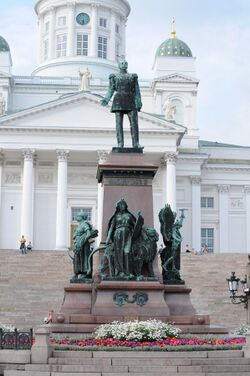
Well-known statues and monuments strongly embedded in the cityscape of Helsinki include the Keisarinnankivi ("Stone of the Empress", 1835), the statue of Russian Emperor Alexander II (1894), the fountain sculpture Havis Amanda (1908), the Paavo Nurmi statue (1925), the Three Smiths Statue (1932), the Aleksis Kivi Memorial (1939), the Eino Leino Statue (1953), the Equestrian statue of Marshal Mannerheim (1960) and the Sibelius Monument (1967).[94]
Government
As is the case with all Finnish municipalities, Helsinki's city council is the main decision-making organ in local politics, dealing with issues such as urban planning, schools, health care, and public transport. The council is chosen in the nationally held municipal elections, which are held every four years.
Helsinki's city council consists of eighty-five members. Following the most recent municipal elections in 2017, the three largest parties are the National Coalition Party (25), the Green League (21), and the Social Democratic Party (12).[95]
The Mayor of Helsinki is Juhana Vartiainen.
Demographics
Population
| Historical population | ||
|---|---|---|
| Year | Pop. | ±% |
| 1875 | 23,070 | — |
| 1880 | 36,346 | +57.5% |
| 1890 | 56,236 | +54.7% |
| 1900 | 79,126 | +40.7% |
| 1910 | 118,736 | +50.1% |
| 1920 | 152,200 | +28.2% |
| 1930 | 205,833 | +35.2% |
| 1940 | 252,484 | +22.7% |
| 1950 | 368,519 | +46.0% |
| 1960 | 448,315 | +21.7% |
| 1970 | 523,677 | +16.8% |
| Source: Statistical Yearbook of Helsinki[96] | ||
The city of Helsinki has Template:Data Finland municipality/population count inhabitants, making it the most populous municipality in Finland and the third in the Nordics. The Greater Helsinki region is the largest urbanised area in Finland with 1,641,329 inhabitants. The city of Helsinki is home to 12% of Finland's population. 18.6% of the population has a foreign background, which is twice above the national average. However, it is lower than in the major Finnish cities of Espoo or Vantaa.[97]
At 53 percent of the population, women form a greater proportion of Helsinki residents than the national average of 51 percent. Helsinki's population density of 2,739.36 people per square kilometre makes Helsinki the most densely-populated city in Finland. The life expectancy for men and women is slightly below the national averages: 75.1 years for men as compared to 75.7 years, 81.7 years for women as compared to 82.5 years.[98][99]
Helsinki has experienced strong growth since the 1810s, when it replaced Turku as the capital of the Grand Duchy of Finland, which later became the sovereign Republic of Finland. The city continued its growth from that time on, with an exception during the Finnish Civil War. From the end of World War II up until the 1970s there was a massive exodus of people from the countryside to the cities of Finland, in particular Helsinki. Between 1944 and 1969 the population of the city nearly doubled from 275,000[100] to 525,600.[101]
In the 1960s, the population growth of Helsinki began to decrease, mainly due to a lack of housing.[102] Some residents began to move to the neighbouring cities of Espoo and Vantaa, resulting in increased population growth in both municipalities. Espoo's population increased ninefold in sixty years, from 22,874 people in 1950 to 244,353 in 2009.[103] Vantaa saw an even more dramatic change in the same time span: from 14,976 in 1950 to 197,663 in 2009, a thirteenfold increase. These population changes prompted the municipalities of Greater Helsinki into more intense cooperation in areas such as public transportation[104] – resulting in the foundation of HSL – and waste management.[105] The increasing scarcity of housing and the higher costs of living in the capital region have pushed many daily commuters to find housing in formerly rural areas, and even further, to cities such as Lohja, Hämeenlinna, Lahti, and Porvoo.
| Year | Population |
|---|---|
| 1980 | 483,036
|
| 1985 | 485,795
|
| 1990 | 492,795
|
| 1995 | 525,031
|
| 2000 | 555,474
|
| 2005 | 560,905
|
| 2010 | 588,549
|
| 2015 | 628,208
|
| 2020 | 656,920
|
Language
Population by mother tongue (2022)[97]
The city of Helsinki is officially bilingual, with both Finnish and Swedish as official languages. In 2022, the majority of the population, 76.1%, spoke Finnish as their mother tongue. There were Template:Data Finland municipality/native language Swedish Swedish speakers, or 5.5% of the population. The number of people who speak Sámi, Finland's third official language, is only Template:Data Finland municipality/native language Sami inhabitants. In Helsinki, 18.3% of the population speak a mother tongue other than Finnish or Swedish.[97] As English and Swedish are compulsory school subjects, functional bilingualism or trilingualism acquired through language studies is not uncommon.
Although few people speak the Sámi languages as their mother tongue, there are 527 people of Sami origin.[106] There are 93 Tatar speakers in Helsinki, almost half of the total number of Tatar speakers in Finland.
Helsinki slang is a regional dialect of the city. Historically, it was a combination of Finnish and Swedish, with influences from Russian and German. Nowadays it has a strong English influence. Today, however, Finnish is the common language of communication between Finnish speakers, Swedish speakers and speakers of other languages (New Finns) in everyday public life between strangers.[107][108]
The city of Helsinki and the national authorities have specifically targeted Swedish speakers. Knowledge of Finnish is essential in business and is usually a basic requirement in the labour market.[109] Swedish speakers are most concentrated in the southern parts of the city. The district with the most Swedish speakers is Ullanlinna/Ulrikasborg with 2,098 (19.6%), while Byholmen is the only district where Swedish is the majority language (at 82.8%). The number of Swedish speakers decreased every year until 2008, and has increased every year since then. Since 2007, the number of Swedish speakers has increased by 2,351.[110] In 1890, Finnish speakers overtook Swedish speakers to become the majority of the city's population.[111] At that time, the population of Helsinki was 61,530.[112]
The number of people with a foreign mother tongue is expected to reach 196,500 in 2035, representing 26% of the population. 114,000 will speak non-European languages, or 15% of the population.[113] Today, at least 160 different languages are spoken in Helsinki. The most common foreign languages are Russian (3.1%), Somali (2.0%), Estonian (1.5%) and Arabic (1.5%).[97]
Immigration
| Population by country of birth (2022)[97] | ||
| Nationality | Population | % |
|---|---|---|
| 555,109 | 83.6 | |
| 13,533 | 2.0 | |
| 10,400 | 1.6 | |
| 6,883 | 1.0 | |
| 5,818 | 0.9 | |
| 3,975 | 0.6 | |
| 3,876 | 0.6 | |
| 3,562 | 0.5 | |
| 2,672 | 0.4 | |
| 2,433 | 0.4 | |
| 2,370 | 0.4 | |
| Other | 53,397 | 8.0 |
In 2022, there were 123,676 people with an immigrant background living in Helsinki, or 18.6% of the population.[note 1] There were 108,919 residents who were born abroad, or 16.4% of the population. The number of foreign citizens in Helsinki was 73,076.[115]
The relative share of immigrants in Helsinki's population is twice the national average, and the city's new residents are increasingly of foreign origin.[97] This will increase the proportion of foreign residents in the coming years. As a crossroads of many international ports and Finland's largest airport, Helsinki is the global gateway to and from Finland.
Most foreign-born citizens come from the former Soviet Union, Estonia, Somalia, Iraq, and Russia .[97]
Religion
In 2022, the Evangelical Lutheran Church was the largest religious group with 47.6% of the Helsinki population. Other religious groups made up 4.5% of the population. 47.9% of the population had no religious affiliation.[97]
The most important churches in Helsinki are Helsinki Cathedral (1852), Uspenski Cathedral (1868), St. John's Church (1891), Kallio Church (1912) and Temppeliaukio Church (1969).
There are 21 Lutheran congregations in Helsinki, 18 of which are Finnish-speaking and 3 are Swedish-speaking. These form Helsinki's congregationgroup. Outside that there is Finland's German congregation with 3,000 members and Rikssvenska Olaus Petri-församlingen for Swedish-citizens with 1,000 members.[116]
The largest Orthodox congregation is the Orthodox Church of Helsinki. It has 20,000 members. Its main church is the Uspenski Cathedral.[117] The two largest Catholic congregations are the Cathedral of Saint Henry, with 4,552 members, established in 1860 and St Mary's Catholic Parish, with 4,107 members, established in 1954.[118]
There are around 30 mosques in the Helsinki region. Many linguistic and ethnic groups such as Bangladeshis, Kosovars, Kurds and Bosniaks have established their own mosques.[119] The largest congregation in both Helsinki and Finland is the Helsinki Islamic Center (fi), established in 1995. It has over 2,800 members (As of 2017), and it received €24,131 in government assistance.[120]
In 2015, imam Anas Hajar (fi) estimated that on big celebrations around 10,000 Muslims visit mosques.[121] In 2004, it was estimated that there were 8,000 Muslims in Helsinki, 1.5% of the population at the time.[122] The number of people in Helsinki with a background from Muslim majority countries was nearly 41,000 as of 2021, representing over 6% of the population.
The main synagogue of Helsinki is the Helsinki Synagogue from 1906, located in Kamppi. It has over 1,200 members, out of the 1,800 Jews in Finland, and it is the older of the two buildings in Finland originally built as a synagogue, followed by the Turku Synagogue in 1912.[123] The congregation includes a synagogue, Jewish kindergarten, school, library, Jewish meat shop, two Jewish cemeteries and an retirement home. Many Jewish organizations and societies are based there, and the synagogue publishes the main Jewish magazine in Finland, HaKehila (fi).[124]
Economy
Greater Helsinki generates approximately one third of Finland's GDP. GDP per capita is roughly 1.3 times the national average.[125] Helsinki profits on serviced-related IT and public sectors. Having moved from heavy industrial works, shipping companies also employ a substantial number of people.[126]
The metropolitan area's gross value added per capita is 200% of the mean of 27 European metropolitan areas, equalling those of Stockholm and Paris. The gross value added annual growth has been around 4%.[127]
83 of the 100 largest Finnish companies have their headquarters in Greater Helsinki. Two-thirds of the 200 highest-paid Finnish executives live in Greater Helsinki and 42% in Helsinki. The average income of the top 50 earners was 1.65 million euro.[128]
The tap water is of excellent quality and it is supplied by the 120 km (75 mi) Päijänne Water Tunnel, one of the world's longest continuous rock tunnels.[129]
Education
Helsinki has 190 comprehensive schools, 41 upper secondary schools, and 15 vocational institutes. Half of the 41 upper secondary schools are private or state-owned, the other half municipal. There are two major research universities in Helsinki, the University of Helsinki and Aalto University, and a number of other higher level institutions and polytechnics which focus on higher-level professional education.
Research universities
- University of Helsinki
- Aalto University (Espoo)
Other institutions of higher education
- Hanken School of Economics
- University of the Arts Helsinki
- National Defence University
- Haaga-Helia University of Applied Sciences
- Laurea University of Applied Sciences
- Helsinki Metropolia University of Applied Sciences
- Arcada University of Applied Sciences
- Diaconia University of Applied Sciences
- HUMAK University of Applied Sciences
Helsinki is one of the co-location centres of the Knowledge and Innovation Community (Future information and communication society) of The European Institute of Innovation and Technology (EIT).[130]
Culture
Museums
The biggest historical museum in Helsinki is the National Museum of Finland, which displays a vast collection from prehistoric times to the 21st century. The museum building itself, a national romantic-style neomedieval castle, is a tourist attraction. Another major historical museum is the Helsinki City Museum, which introduces visitors to Helsinki's 500-year history. The University of Helsinki also has many significant museums, including the Helsinki University Museum "Arppeanum" and the Finnish Museum of Natural History.
The Finnish National Gallery consists of three museums: Ateneum Art Museum for classical Finnish art, Sinebrychoff Art Museum for classical European art, and Kiasma Art Museum for modern art, in a building by architect Steven Holl. The old Ateneum, a neo-Renaissance palace from the 19th century, is one of the city's major historical buildings. All three museum buildings are state-owned through Senate Properties.
The city of Helsinki hosts its own art collection in the Helsinki Art Museum (HAM), primarily located in its Tennispalatsi gallery. Around 200 pieces of public art lie outside. The art is all city property.
Helsinki Art Museum will in 2020 launch the Helsinki Biennial, which will bring art to maritime Helsinki – in its first year to the island of Vallisaari.[131]
The Design Museum is devoted to the exhibition of both Finnish and foreign design, including industrial design, fashion, and graphic design. Other museums in Helsinki include the Military Museum of Finland, Didrichsen Art Museum, Amos Rex Art Museum, and the Tram Museum (fi).
- Museums in Helsinki
The National Museum of Finland (1910)
Theatres
Helsinki has three major theatres: The Finnish National Theatre, the Helsinki City Theatre, and the Swedish Theatre (Svenska Teatern). Other notable theatres in the city include the Alexander Theatre, Q-teatteri (fi), Savoy Theatre (Helsinki) (fi), KOM-theatre (fi), and Teatteri Jurkka (fi).
Music
Helsinki is home to two full-size symphony orchestras, the Helsinki Philharmonic Orchestra and the Finnish Radio Symphony Orchestra, both of which perform at the Helsinki Music Centre concert hall. Acclaimed contemporary composers Kaija Saariaho, Magnus Lindberg, Esa-Pekka Salonen, and Einojuhani Rautavaara, among others, were born and raised in Helsinki, and studied at the Sibelius Academy. The Finnish National Opera, the only full-time, professional opera company in Finland, is located in Helsinki. The opera singer Martti Wallén, one of the company's long-time soloists, was born and raised in Helsinki, as was mezzo-soprano Monica Groop.
Many widely renowned and acclaimed bands have originated in Helsinki, including Nightwish, Children of Bodom, Hanoi Rocks, HIM, Stratovarius, The 69 Eyes, Finntroll, Ensiferum, Wintersun, The Rasmus, Poets of the Fall, and Apocalyptica. The most significant of the metal music events in Helsinki is the Tuska Open Air Metal Festival in Suvilahti, Sörnäinen.[132]
The city's main musical venues are the Finnish National Opera, the Finlandia concert hall, and the Helsinki Music Centre. The Music Centre also houses a part of the Sibelius Academy. Bigger concerts and events are usually held at one of the city's two big ice hockey arenas: the Helsinki Halli or the Helsinki Ice Hall. Helsinki has Finland's largest fairgrounds, the Messukeskus Helsinki, which is attended by more than a million visitors a year.[133]
Helsinki Arena hosted the Eurovision Song Contest 2007, the first Eurovision Song Contest arranged in Finland, following Lordi's win in 2006.[134]
Art
The Helsinki Day (Helsinki-päivä) will be celebrated on every 12 June, with numerous entertainment events culminating in an open-air concert.[135][136] Also, the Helsinki Festival is an annual arts and culture festival, which takes place every August (including the Night of the Arts).[137]
At the Senate Square in fall 2010, Finland's largest open-air art exhibition to date took place: About 1.4 million people saw the international exhibition of United Buddy Bears.[138]
Helsinki was the 2012 World Design Capital, in recognition of the use of design as an effective tool for social, cultural, and economic development in the city. In choosing Helsinki, the World Design Capital selection jury highlighted Helsinki's use of 'Embedded Design', which has tied design in the city to innovation, "creating global brands, such as Nokia, Kone, and Marimekko, popular events, like the annual Helsinki Design Week (fi), outstanding education and research institutions, such as the Aalto University School of Arts, Design and Architecture, and exemplary architects and designers such as Eliel Saarinen and Alvar Aalto".[11]
Helsinki hosts many film festivals. Most of them are small venues, while some have generated interest internationally. The most prolific of these is the Helsinki International Film Festival – Love & Anarchy film festival, also known as Helsinki International Film Festival, which features films on a wide spectrum. Night Visions, on the other hand, focuses on genre cinema, screening horror, fantasy, and science fiction films in very popular movie marathons that last the entire night. Another popular film festival is DocPoint (film festival) (fi), a festival that focuses solely on documentary cinema.[139][140][141]
Media
Sanoma publishes Finland's journal of record, Helsingin Sanomat, the tabloid Ilta-Sanomat, the commerce-oriented Taloussanomat, and the television channel Nelonen. Another Helsinki-based media house, Alma Media, publishes over thirty magazines, including the tabloid Iltalehti, and the commerce-oriented Kauppalehti.
Finland's national public-broadcasting institution Yle operates five television channels and thirteen radio channels in both national languages. Yle is headquartered in the neighbourhood of Pasila. All TV channels are broadcast digitally, both terrestrially and on cable. Yle's studio area houses the 146-metre (479 ft) high television and radio tower, Yle Transmission Tower (Pasilan linkkitorni),[142] which is the third tallest structure in Helsinki and one of Helsinki's most famous landmarks, from the top of which, in good weather, can be seen even as far as Tallinn over the Gulf of Finland.[143]
The commercial television channel MTV3 and commercial radio channel Radio Nova are owned by Nordic Broadcasting (Bonnier and Proventus).
Food
Helsinki was already known in the 18th century for its abundant number of inns and pubs, where both locals and those who landed in the harbor were offered plenty of alcoholic beverages.[144] At that time, taxes on the sale of alcohol were a very significant source of income for Helsinki, and one of the most important sellers of alcohol was Johan Sederholm (fr) (1722–1805), a trade councilor who attracted rural merchants with alcohol and made good deals.[144] Gradually, a new kind of beverage culture began to grow in the next century, and as early as 1852, the first café of Finland, Café Ekberg (fi),[145][146] was established by confectioner Fredrik Ekberg (fi) (1825–1891) after attending his studies in St. Petersburg. Ekberg has also been said to have created Finland's "national pastry tradition".[147] At first, café culture was only a prerogative of sophisticated elite, when it recently began to take shape as the right of every man.[148] Today, there are several hundred cafés in Helsinki, the most notable of which is Cafe Regatta, which is very popular with foreign tourists.[149][150][151]
As an important port city on the Baltic Sea, Helsinki has long been known for its fish food, and it has recently started to become one of the leading fish food capitals in Northern Europe.[152] Helsinki's Market Square is especially known for its traditional herring market, which has been organized since 1743.[153][154][155][156] Salmon is also a typical Helsinki fish dish, both fried and souped.[157] The most prestigious restaurants specializing in seafood include Restaurant Fisken på Disken.[158][159]
Helsinki is currently experiencing a period of booming food culture, and it has developed into an internationally acclaimed food city, receiving recognition for promoting food culture.[156][160][161] The local food culture is made up of cuisines from around the world and the fusions they form. Various Asian restaurants such as Chinese, Thai, Indian and Nepalese are particularly prominent in Helsinki's cityscape, but over the past couple of years, restaurants serving Vietnamese food have been very popular.[152] Sushi restaurant buffets have also made their way into the city's restaurant offerings in one fell swoop.[152] The third prominent trend is restaurants serving pure local food, many of which specialize primarily in serving pure Nordic flavors.[152] In past years Middle Eastern food culture rose in its popularity. Especially Helsinki's eastern part offers many different options for Middle Eastern cuisine lovers.[162] There is also some touches of Russian cuisine, one of which is the Finnish version of blinis, a thick pancakes that are usually fried in a cast iron pan.[163] One of the most significant food culture venues in Helsinki is the general public area known as Teurastamo in the Hermanni district, which operated as the city's slaughterhouse between 1933 and 1992, to which the name of the place also refers.[156][164][165]
A nationwide food carnival called Restaurant Day (Ravintolapäivä) has begun in Helsinki and has traditionally been celebrated since May 2011.[166] The purpose of the day is to have fun, share new food experiences and enjoy the common environment with the group.[156]
Other
Vappu is an annual carnival for students and workers on 1 May. The last week of June marks the Helsinki Pride human rights event, which was attended by 100,000 marchers in 2018.[167]
Sports
Helsinki has a long tradition of sports: the city gained much of its initial international recognition during the 1952 Summer Olympics, and the city has arranged sporting events such as the first World Championships in Athletics 1983 and 2005, and the European Championships in Athletics 1971, 1994, and 2012. Helsinki hosts successful local teams in both of the most popular team sports in Finland: football and ice hockey. Helsinki houses HJK Helsinki, Finland's largest and most successful football club, and IFK Helsingfors, their local rivals with 7 championship titles. The fixtures between the two are commonly known as Stadin derby. Helsinki's track and field club Helsingin Kisa-Veikot is also dominant within Finland. Ice hockey is popular among many Helsinki residents, who usually support either of the local clubs IFK Helsingfors (HIFK) or Jokerit. HIFK, with 14 Finnish championships titles, also plays in the highest bandy division,[168] along with Botnia-69. The Olympic stadium hosted the first ever Bandy World Championship in 1957.[169]
Helsinki was elected host-city of the 1940 Summer Olympics, but due to World War II they were canceled. Instead Helsinki was the host of the 1952 Summer Olympics. The Olympics were a landmark event symbolically and economically for Helsinki and Finland as a whole that was recovering from the winter war and the continuation war fought with the Soviet Union. Helsinki was also in 1983 the first ever city to host the World Championships in Athletics. Helsinki also hosted the event in 2005, thus also becoming the first city to ever host the Championships for a second time. The Helsinki City Marathon has been held in the city every year since 1981, usually in August.[170] A Formula 3000 race through the city streets was held on 25 May 1997. In 2009 Helsinki was host of the European Figure Skating Championships, and in 2017 it hosted World Figure Skating Championships. The city will host the 2021 FIBA Under-19 Basketball World Cup.
Most of Helsinki's sports venues are under the responsibility of the city's sports office, such as 70 sports halls and about 350 sports fields. There are nine ice rinks, three of which are managed by the Helsinki Sports Agency (Helsingin liikuntavirasto).[171] In winter, there are seven artificial ice rinks. People can swim in Helsinki in 14 swimming pools, the largest of which is the Mäkelänrinne Swimming Centre (fi),[172] two inland swimming pools and more than 20 beaches, of which Hietaniemi Beach is probably the most famous.[173]
Transport
Roads
The backbone of Helsinki's motorway network consists of three semicircular beltways, Ring I, Ring II, and Ring III, which connect expressways heading to other parts of Finland, and the western and eastern arteries of Länsiväylä and Itäväylä respectively. While variants of a Keskustatunneli tunnel under the city centre have been repeatedly proposed, (As of 2017) the plan remains on the drawing board.
Many important Finnish highways leave Helsinki for various parts of Finland; most of them in the form of motorways, but a few of these exceptions include Vihdintie. The most significant highways are:
- Finnish national road 1/E18 (to Lohja, Salo and Turku)
- Finnish national road 3/E12 (to Hämeenlinna, Tampere and Vaasa)
- Finnish national road 4/E75 (to Lahti, Jyväskylä, Oulu and Rovaniemi)
- Finnish national road 7/E18 (to Porvoo and Kotka).
Helsinki has some 390 cars per 1000 inhabitants.[174] This is less than in cities of similar population and construction density, such as Brussels' 483 per 1000, Stockholm's 401, and Oslo's 413.[175][176]
Intercity rail
Helsinki Central Railway Station is the main terminus of the rail network in Finland. Two rail corridors lead out of Helsinki, the Main Line to the north (to Tampere, Oulu, Rovaniemi), and the Coastal Line to the west (to Turku). The Main Line (päärata), which is the first railway line in Finland, was officially opened on 17 March 1862, between cities of Helsinki and Hämeenlinna.[177] The railway connection to the east branches from the Main Line outside of Helsinki at Kerava, and leads via Lahti to eastern parts of Finland.
A majority of intercity passenger services in Finland originate or terminate at the Helsinki Central Railway Station. All major cities in Finland are connected to Helsinki by rail service, with departures several times a day. The most frequent service is to Tampere, with more than 25 intercity departures per day (As of 2017).
Until 2022 there also was an international services from Helsinki to Saint Petersburg and Moscow. The Saint Petersburg to Helsinki route was operated by Allegro high-speed trains.
A Helsinki to Tallinn Tunnel has been proposed[178] and agreed upon by representatives of the cities.[179] The rail tunnel would connect Helsinki to the Estonian capital Tallinn, further linking Helsinki to the rest of continental Europe by Rail Baltica.
Aviation
Air traffic is handled primarily from Helsinki Airport, located approximately 17 kilometres (11 mi) north of Helsinki's downtown area, in the neighbouring city of Vantaa. Helsinki's own airport, Helsinki-Malmi Airport, is mainly used for general and private aviation. Charter flights are available from Hernesaari Heliport.
Sea transport
Like many other cities, Helsinki was deliberately founded at a location on the sea in order to take advantage of shipping. The freezing of the sea imposed limitations on sea traffic up to the end of the 19th century. But for the last hundred years, the routes leading to Helsinki have been kept open even in winter with the aid of icebreakers, many of them built in the Helsinki Hietalahti shipyard. The arrival and departure of ships has also been a part of everyday life in Helsinki. Regular route traffic from Helsinki to Stockholm, Tallinn, and Saint Petersburg began as far back as 1837. Over 300 cruise ships and 360,000 cruise passengers visit Helsinki annually. There are international cruise ship docks in South Harbour, Katajanokka, West Harbour, and Hernesaari. In terms of combined liner and cruise passengers, the Port of Helsinki overtook the Port of Dover in 2017 to become the busiest passenger port in the world.[180]
Ferry connections to Tallinn, Mariehamn, and Stockholm are serviced by various companies; very popular MS J. L. Runeberg ferry connection to Finland's second oldest city, medieval old town of Porvoo, is also available for tourists.[181] Finnlines passenger-freight ferries to Gdynia, Poland; Travemünde, Germany; and Rostock, Germany are also available. St. Peter Line offers passenger ferry service to Saint Petersburg several times a week.
Urban transport
In the Helsinki metropolitan area, public transportation is managed by the Helsinki Regional Transport Authority, the metropolitan area transportation authority. The diverse public transport system consists of trams, commuter rail, the metro, bus lines, two ferry lines and a public bike system.
Helsinki's tram system dates back to 1891 when the first horse-drawn trams were introduced; the system was electrified in 1900.[182] (As of January 2024), the system consists of 14 routes covering the inner part of the city center and one newer light rail style line connecting Keilaniemi in Espoo with Itäkeskus in eastern Helsinki. The length of the network is planned to more than double during the 2020s and 2030s compared to 2021, with major projects including Vantaa light rail, the Crown Bridges link to the island of Laajasalo and the West Helsinki light rail project connecting Kannelmäki to the city center.[183] Construction work on the new tram as the number line 13 (Nihti–Kalasatama–Vallilanlaakso–Pasila) has begun in May 2020, and the line is scheduled for completion in 2024.[184]
The commuter rail system includes purpose-built double track for local services in two rail corridors along intercity railways, and the Ring Rail Line, an urban double-track railway with a station at the Helsinki Airport in Vantaa. Electric operation of commuter trains was first begun in 1969, and the system has been gradually expanded since. 15 different services are operated (As of 2017), some extending outside of the Helsinki region. The frequent services run at a 10-minute headway in peak traffic.
International relations
Twin towns and sister cities
Helsinki is officially the sister city of Beijing, China (since 2006).[185][186][187] In addition, the city has a special partnership relation with:
Until 2022, Helsinki also had an international partnership with the Russian cities of Moscow and Saint Petersburg.[188]
Notable people
Born before 1900
- Peter Forsskål (1732–1763), Swedish-Finnish naturalist and orientalist
- Axel Hampus Dalström (1829–1882), architect
- Maria Tschetschulin (1850–1917), clerk
- Augusta Krook (1853–1941), politician and teacher
- Agnes Tschetschulin (1859–1942), composer and violinist
- Jakob Sederholm (1863–1934), petrologist
- Karl Fazer (1866–1932), baker, confectioner, chocolatier, entrepreneur, and sport shooter
- Emil Lindh (1867–1937), sailor
- Oskar Merikanto (1868–1924), composer
- Signe Lagerborg-Stenius (1870–1968), architect and member the Helsinki City Council
- Maggie Gripenberg (1881–1976), dancer
- Gunnar Nordström (1881–1923), theoretical physicist
- Väinö Tanner (1881–1966), politician
- Walter Jakobsson (1882–1957), figure-skater
- Mauritz Stiller (1883–1928), Russian-Swedish director and screenwriter
- Karl Wiik (1883–1946), Social Democratic politician
- Lennart Lindroos (1886–1921), swimmer, Olympic games 1912
- Erkki Karu (1887–1935), film director and producer
- Kai Donner (1888–1935), linguist, anthropologist and politician
- Gustaf Molander (1888–1973), Swedish director and screenwriter
- Johan Helo (1889–1966), lawyer and politician
- Minna Craucher (1891–1932), socialite and spy
- Artturi Ilmari Virtanen (1895–1973), chemist (Nobel Prize, 1945)
- Rolf Nevanlinna (1895–1980), mathematician, university teacher and writer
- Elmer Diktonius (1896–1961), Finnish-Swedish writer and composer
- Yrjö Leino (1897–1961), communist politician
- Toivo Wiherheimo (1898–1970), economist and politician
Born after 1900
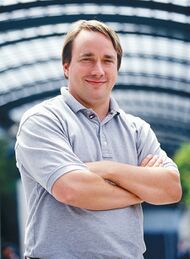
- Aku Ahjolinna (born 1946), ballet dancer and choreographer
- Lars Ahlfors (1907–1996), mathematician, Fields medalist
- Ella Eronen (1900–1987), actress and poetic recite
- Tuomas Holopainen (born 1976), songwriter, multi-instrumentalist and record producer
- Helena Anhava (1925–2018), poet, author and translator
- Paavo Berglund (1929–2012), conductor
- Laci Boldemann (1921–1969), composer
- Irja Agnes Browallius (1901–1968), Swedish writer
- Bo Carpelan (1926–2011), Finland-Swedish writer, literary critic and translator
- Tarja Cronberg (born 1943), politician
- Jörn Donner (1933–2020), writer, film director and politician
- George Gaynes (1917–2016), American television and film actor
- Ragnar Granit (1900–1991), Finnish-Swedish neurophysiologist and Nobel laureate
- Mika Waltari (1908–1979), writer
- Elina Haavio-Mannila (born 1933), social scientist and professor
- Tarja Halonen (born 1943), President of Finland
- Reino Helismaa (1913–1965), writer, film actor and singer
- Kim Hirschovits (born 1982), ice hockey player
- Bengt Holmström (born 1949), Professor of Economics, Nobel laureate
- Shawn Huff (born 1984), basketball player
- Ville Husso (born 1995), ice hockey goaltender
- Kirsti Ilvessalo (1920–2019), textile artist
- Tove Jansson (1914–2001), Finland-Swedish writer, painter, illustrator, comic writer, graphic designer
- Kaapo Kähkönen (born 1996), ice hockey goaltender
- Aki Kaurismäki (born 1957), director, screenwriter and producer
- Emma Kimiläinen (born 1989), racing driver
- Kiti Kokkonen (born 1974), Finnish actress and writer
- Petteri Koponen, basketball player
- Lennart Koskinen (born 1944), Swedish, Lutheran bishop
- Sam Lake (born 1970), writer and actor; the creative director at Remedy Entertainment
- Olli Lehto (1925–2020), mathematician
- Samuel Lehtonen (1921–2010), bishop of the Evangelical Lutheran Church of Finland
- Juha Leiviskä (born 1936), architect
- Magnus Lindberg (born 1958), composer and pianist
- Esa Lindell (born 1994), professional ice hockey player
- Lill Lindfors (born 1940), Finland-Swedish singer and TV presenter
- Jari Mäenpää (born 1977), founder, former lead guitarist and current lead singer in melodic death metal band Wintersun, former lead singer and guitarist of folk metal band Ensiferum
- Klaus Mäkelä (born 1996), cellist and conductor
- Susanna Mälkki (born 1969), conductor
- Georg Malmstén (1902–1981), singer, musician, composer, orchestra director and actor
- Tauno Marttinen (1912–2008), composer
- Vesa-Matti Loiri (1945-2022), actor, comedian, singer
- Abdirahim Hussein Mohamed (born 1978), Finnish-Somalian media personality and politician
- Hanno Möttölä, Finnish basketball player
- Väinö Myllyrinne (1909–1963), acromegalic giant and at time (1940–1963) the world's tallest living person
- Peter Nygård (born 1941), businessman, arrested in December 2020 for sex crimes
- Markku Peltola (1956–2007), actor and musician
- Kimmo Pikkarainen (born 1976), professional ice hockey player
- Anne Marie Pohtamo (born 1955), actress, model, Miss Suomi 1975 and Miss Universe 1975
- Elisabeth Rehn (born 1935), politician
- Einojuhani Rautavaara (1928–2016), composer
- Susanne Ringell (born 1955), writer and actress
- Miron Ruina (born 1998), Finnish-Israeli basketball player
- Kaija Saariaho (1952-2023), composer
- Riitta Salin (born 1950), athlete
- Sasu Salin, Finnish basketball player
- Esa-Pekka Salonen (born 1958), composer and conductor
- Asko Sarkola (born 1945), actor
- Heikki Sarmanto (born 1939), jazz pianist and composer
- Teemu Selänne (born 1970), Hall of Fame ice hockey player
- Ann Selin (born 1960), trade union leader
- Birgit Sergelius (1907–1979), stage and film actress
- Teuvo Teräväinen (born 1994), professional ice hockey player
- Märta Tikkanen (born 1935), Finland-Swedish writer and philosophy teacher
- Linus Torvalds (born 1969), software engineer, creator of Linux
- Elin Törnudd (1924–2008), Finnish chief librarian and professor
- Klaus Törnudd (born 1931), diplomat and political scientist
- Sirkka Turkka (1939–2021), poet
- Jarno Tuunainen (born 1977), footballer
- Ville Valo (born 1976), lead singer of the rock band HIM
- Ulla Vuorela (1945–2011), professor of social anthropology
- Lauri Ylönen (born 1979), lead singer of the rock band The Rasmus
See also
- Timeline of Helsinki § Bibliography
- Greater Helsinki
- Helsinki urban area
- Subdivisions of Helsinki
- Helsinki Parish Village
- Underground Helsinki
Notes
References
- ↑ 1.0 1.1 Ainiala, Terhi (2009). "Place Names in the Construction of Social Identities: The Uses of Names of Helsinki". Research Institute for the Languages of Finland. http://yorkspace.library.yorku.ca/xmlui/handle/10315/2924.
- ↑ 2.0 2.1 [1] [yes|permanent dead link|dead link}}]
- ↑ 3.0 3.1 "Helsinki, Pearl of the Baltic Sea". https://www.myhelsinki.fi/en/my-helsinki/helsinki-pearl-of-the-baltic-sea.
- ↑ "Helsinki elevation". https://elevation.city/fi/e3w1.
- ↑ "Helsinki". Boston: Houghton Mifflin Harcourt. 2014. https://www.ahdictionary.com/word/search.html?q=Helsinki.
- ↑ "Helsinki". HarperCollins. https://www.collinsdictionary.com/amp/english/helsinki.
- ↑ Cite error: Invalid
<ref>tag; no text was provided for refs namedpopulation_count - ↑ "Taulukko: Taajamat väkiluvun ja väestöntiheyden mukaan 31.12.2017" (in fi). 31 December 2017. http://pxnet2.stat.fi/PXWeb/pxweb/en/StatFin/StatFin__vrm__vaerak/statfin_vaerak_pxt_027_fi.px.
- ↑ "Cities of Finland". Eurostat. http://epp.eurostat.ec.europa.eu/portal/page/portal/region_cities/city_urban/city_maps/FI.
- ↑ "Sipoo - kahden keskuksen kunta Helsingin tuntumassa". https://ta.fi/ajankohtaista/499-sipoo-kahden-keskuksen-kunta-helsingin-tuntumassa.
- ↑ 11.0 11.1 "Past capital: Helsinki". Worlddesigncapital.com. http://www.worlddesigncapital.com/world-design-capitals/past-capital-helsinki/.
- ↑ "Most liveable city: Helsinki — Monocle Film / Affairs". Monocle.com. http://monocle.com/film/affairs/most-liveable-city-helsinki/.
- ↑ "Global Liveability Ranking 2016". https://www.eiu.com/public/topical_report.aspx?campaignid=liveability2016.
- ↑ "Helsinki: The World's 100 Greatest Places of 2021". https://time.com/collection/worlds-greatest-places-2021/6079245/helsinki/.
- ↑ "Helsinki comes in third in ranking of world's best cities to live". Helsinki Times. 14 July 2021. https://www.helsinkitimes.fi/finland/finland-news/domestic/19591-helsinki-comes-in-third-in-ranking-of-world-s-best-cities-to-live.html.
- ↑ Ghouri, Farah (4 August 2021). "London hailed as world's 'city of choice' in quality of life report". City A.M.. https://www.cityam.com/london-hailed-as-worlds-city-of-choice-by-bcg-report/.
- ↑ "The friendliest cities in Europe: 2023 Readers' Choice Awards". Condé Nast Traveler. 3 October 2023. https://www.cntraveller.com/gallery/friendliest-cities-europe.
- ↑ Lapin Kansa: Rovaniemen ja Helsingin johtajat saivat ministeriltä tehtävän miettiä, miten matkailu nousee korona-ajan mentyä ohi – Rahaa on luvassa EU:n elpymispaketista (in Finnish)
- ↑ Roberts, Toby; Williams, Ian; Preston, John (2021). "The Southampton system: A new universal standard approach for port-city classification". Maritime Policy & Management 48 (4): 530–542. doi:10.1080/03088839.2020.1802785.
- ↑ Salminen, Tapio (2013) (in fi). Vantaan ja Helsingin pitäjän keskiaika. Vantaa: Vantaan kaupunki. ISBN 978-952-443-455-3.
- ↑ Hellman, Sonja (7 June 2015). "Historiska fel upprättas i ny bok" (in sv). Hufvudstadsbladet.
- ↑ "Utbildning & Vetenskap: Svenskfinland". Veta.yle.fi. http://veta.yle.fi/svenskfinland/artikel.php?id=23&subject=mellannyland.
- ↑ "Onko kosken alkuperäinen nimi Helsinginkoski vai Vanhankaupunginkoski?". http://www.helsinginkoski.fi/kysymyksetjavastaukset/onko-kosken-alkuperainen-nimi-helsinginkoski-vai-vanhankaupunginkoski/.
- ↑ Jäppinen, Jere (2007). "Helsingin nimi". Helsingin kaupunginmuseo. http://www.helsinginkaupunginmuseo.fi/wp-content/uploads/2015/07/sofia_2_2007.pdf.
- ↑ Jäppinen, Jere (15 November 2011). "Mistä Helsingin nimi on peräisin?". Helsingin Sanomat: D2. http://www.hs.fi/paivanlehti/arkisto/Mist%C3%A4+Helsingin+nimi+on+per%C3%A4isin/aaHS20111115SI1AT02exp?src=haku&ref=arkisto%2F. Retrieved 29 November 2013.
- ↑ Ristkari, Maiju: Heinäsorsat Helsingissä. Aku Ankka #44/2013, introduction on page 2.
- ↑ "Sami Grammar". http://people.uta.fi/~km56049/same/svocab.html.
- ↑ 28.0 28.1 28.2 28.3 28.4 Kent, Neil (2004). Helsinki: A cultural and literary history. Oxford: Signal Books.
- ↑ 29.0 29.1 V.-P. Suhonen and Janne Heinonen. "Helsingin keskiaikaiset ja uuden ajan alun kylänpaikat 2011, Inventointiraportti. Museovirasto, Arkeologiset kenttäpalvelut". https://www.hel.fi/hel2/kaumuseo/rakennusinventoinnit/raportit/kyl_paikkainventointi.pdf.
- ↑ Tarkiainen, Kari (2010). Ruotsin itämaa. Helsinki: Svenska litteratussällskapet i Finland. pp. 122–125.
- ↑ 31.0 31.1 "Ruttopuisto – Plague Park". Tabblo.com. http://www.tabblo.com/studio/stories/view/409531/.
- ↑ 32.0 32.1 "Helsingin historia" (in fi). http://www.hel.fi/www/Helsinki/fi/kaupunki-ja-hallinto/tietoa-helsingista/helsingin-historia-ja-arkistot/.
- ↑ 33.0 33.1 "Helsinki – Suomi" (in fi). http://matkaoppaat.com/helsinki/.
- ↑ "Suuri Pohjan sota ja Helsingin tuho" (in fi). City of Helsinki. 21 January 2022. https://historia.hel.fi/fi/kaannekohdat/tuho-ja-jalleenrakennus/suuri-pohjan-sota-ja-helsingin-tuho.
- ↑ Aalto, Seppo (2015) (in fi). Kruununkaupunki – Vironniemen Helsinki 1640–1721. Helsinki: Finnish Literature Society. ISBN 978-952-222-675-4.
- ↑ Niukkanen, Marianna; Heikkinen, Markku. "Vuoden 1808 suurpalo" (in fi). National Board of Antiquities. http://www.nba.fi/helsinginarkeologiaa/keskusta_kohteet_1810.htm.
- ↑ "8 April 1812 Emperor Alexander I promotes Helsinki to the capital of the Grand Duchy. - Helsinki 200 years as capital". http://www.helsinki200.fi/en/helsinki-1812-2012/1812-emperor-alexander-i-promotes-helsinki-capital-grand-duchy/.
- ↑ "Bicentennial of Helsinki as Finnish capital". Yle News. 8 April 2012. https://yle.fi/news/3-5486170.
- ↑ "Lobbying for Helsinki 200 years ago". Helsinki Times. 19 April 2012. https://www.helsinkitimes.fi/finland/finland-news/domestic/1978-lobbying-for-helsinki-200-years-ago-2.html.
- ↑ Marjo Vilkko (2014). "Stadin slangi" (in fi). Suomi on ruotsalainen. Helsinki: Schildts & Söderströms. pp. 216–219. ISBN 978-951-52-3419-3.
- ↑ "The White Pearl of the Baltic Sea – Helsinki Deals with Snow". 3 January 2013. https://hooniverse.com/the-white-pearl-of-the-baltic-sea-helsinki-deals-with-snow/.
- ↑ "Geography of Helsinki, Overview of Finland". http://www.easyexpat.com/en/guides/finland/helsinki/overview/geography.htm.
- ↑ "Helsinki — School of Computer Science — SOCS". http://www.cs.mcgill.ca/~rwest/link-suggestion/wpcd_2008-09_augmented/wp/h/Helsinki.htm.
- ↑ Kotka, Tiina (14 May 2020). "Stadilla on 60 luonnonsuojelualuetta" (in fi). Helsinki-lehti (City of Helsinki) (2/2020): 27. https://www.hel.fi/static/liitteet/kanslia/helsinki-info/arkisto/2020/HKI0220_nettilehti_1505.pdf. Retrieved 30 December 2020.
- ↑ "Mitkä ovat Helsingin nimikkoeläin ja nimikkokasvi?" (in fi). Kysy kirjastonhoitajalta. Helsinki City Library. 30 August 2001. http://www.kirjastot.fi/kysy/arkistohaku/kysymys/?ID=4cb7bd80-f847-49dc-a6c9-020fc91899c2.
- ↑ "Aluejaot" (in fi). Uudenmaan liitto. http://www.uudenmaanliitto.fi/tietopalvelut/uusimaa-tietopankki/aluejaot.
- ↑ "Uudenmaan maakuntakaava selostus" (in fi). Helsinki-Uusimaa Region. http://www.uudenmaanliitto.fi/files/1090/Uudenmaan_maakuntakaava_selostus.pdf.
- ↑ "Pääkaupunkiseutu, Suur-Helsinki ja Helsingin seutu" (in fi). Kotus. http://www.kielitoimistonohjepankki.fi/ohje/403.
- ↑ "Helsingin seutu tiivistetysti" (in fi). Helsinginseutu.fi. 19 December 2022. http://www.helsinginseutu.fi/hki/HS/Helsingin+Seutu/Kaupunkitieto+ja+tilastot.
- ↑ "Climate Helsinki: Temperature, Climograph, Climate table for Helsinki - Climate-Data.org". https://en.climate-data.org/location/5971/.
- ↑ "Climatological statistics for the normal period 1971–2000". Fmi.fi. http://en.ilmatieteenlaitos.fi/normal-period-1981-2010.
- ↑ Tukiainen, Matti. "Helsinki, Finland – Sunrise, sunset, dawn and dusk times around the World!". http://www.gaisma.com/en/location/helsinki.html.
- ↑ "Taulukkotilasto: Helsinki Kaisaniemi". Finnish Meteorological Institute. 28 July 2019. https://kilotavu.com/asema-taulukko.php?asema=100971.
- ↑ "Suomen Makkuntien Ilmasto". Helsinki: Finnish Meteorological Institute. 2009. https://helda.helsinki.fi/bitstream/handle/10138/15734/2009nro8.pdf?sequence=1&isAllowed=y.
- ↑ "Helsinki Kaisaniemi - Taulukkotilasto". https://kilotavu.com/asema-taulukko.php?asema=100971.
- ↑ 56.0 56.1 "FMI normals 1991-2020". fmi.fi. https://www.ilmatieteenlaitos.fi/ilmastollinen-vertailukausi.
- ↑ "FMI data". FMI. http://suja.kapsi.fi/fmi-tilastot.php?taulukkomoodi=true.
- ↑ "Helsinki, Finland - Monthly weather forecast and Climate data". Weather Atlas. https://www.weather-atlas.com/en/finland/helsinki-climate.
- ↑ "FMI open data". FMI. https://www.ilmatieteenlaitos.fi/ilmastollinen-vertailukausi.
- ↑ "Kamppi, Kluuvi ja Punavuori" (in fi). City of Helsinki. http://www.hel.fi/www/Helsinki/fi/kaupunki-ja-hallinto/hallinto/kaupunginosat/kamppi-kluuvi-punavuori.
- ↑ "Millainen hotelli Helsingissä kannattaa valita ja miltä alueelta" (in fi). Pieni matkaopas. http://www.pienimatkaopas.com/helsinki/majoittuminen.html.
- ↑ Malmi, Uuttahelsinkiä.fi, (in Finnish)
- ↑ Malmin keskustan suunnitteluperiaatteet päätöksentekoon – STT Info (in Finnish)
- ↑ Tässä on tuleva Itä-Helsingin keskus: Itäväylän päälle rakentuu taloja ja tilaa kaikille, Stoan Puhoksen ja Puotilan metroaseman alueen monikulttuurisuutta halutaan rikastaa – Yle (in Finnish)
- ↑ "Kuninkaanportti" (in fi). Suomenlinna. http://www.suomenlinna.fi/kavijalle/nahtavyydet/kuninkaanportti/.
- ↑ "Vanha kirkko" (in fi). Helsingin seurakunnat. 2012. http://www.helsinginkirkot.fi/fi/kirkot/vanhakirkko.
- ↑ Colston, Penelope (24 January 2013). "In Helsinki, Modern Units to Art Nouveau Gems". The New York Times. http://www.nytimes.com/2013/01/25/greathomesanddestinations/25iht-rehelsinki25.html?pagewanted=all&_r=0.
- ↑ "Säätytalo" (in fi). Virtual Helsinki. http://www.virtualhelsinki.net/info/page_object.php?obj_id=60.
- ↑ "Johanneksenkirkko" (in fi). Helsingin kirkot. http://www.helsinginkirkot.fi/fi/kirkot/johanneksenkirkko.
- ↑ "Ritarihuone" (in fi). Helsingin kaupunginmuseo. https://hkm.finna.fi/Record/hkm.HKMS000005%3A00000tio.
- ↑ "Katedraalit ja tuomiokirkot" (in fi). Discovering finland. http://www.discoveringfinland.com/fi/travel/nae-koe/nahtavyydet-kulttuuri/monumentit/katedraalit/.
- ↑ Willis, David K. (4 August 1983). "When it comes to films on Russia, they've seen enough". Christian Science Monitor. http://www.csmonitor.com/1983/0804/080464.html.
- ↑ Ministry for Foreign Affairs of Finland, Political Department: "Memo 56 of 20 January 1982 (labelled highly confidential in 1982)". http://img.mtv3.fi/mn_liitteet/mtv3/uutiset/bulleting/300538.pdf. (1.37 MB)
- ↑ "Billion Dollar Brain - Film Locations". https://www.movie-locations.com/movies/b/Billion-Dollar-Brain.php.
- ↑ "YLE: Tehtävä Suomessa, Michael Caine! - YLE Teema" (in fi). 18 February 2020. https://yle.fi/aihe/artikkeli/2020/02/18/tehtava-suomessa-michael-caine.
- ↑ Morris, Kieran (6 May 2020). "Deeper Underground: How Helsinki is Building its Future Beneath the City Surface". https://theculturetrip.com/europe/finland/articles/deeper-underground-how-helsinki-is-building-its-future-beneath-the-city-surface/.
- ↑ "Underground Master Plan". https://www.hel.fi/helsinki/en/housing/planning/current/underground-master-plan.
- ↑ "My Helsinki". https://www.myhelsinki.fi/en/see-and-do/underground-helsinki.
- ↑ "Stora Enson pääkonttori, Kanavaranta 1" (in fi). 25 February 2007. http://helsinginaallot.blogspot.com/2007/02/stora-enson-pkonttori-kanavaranta-1.html.
- ↑ "Kohtaako Enson konttori voittajansa?" (in fi). Helsingin Sanomat: Lead editorial. 14 June 2008. http://www.hs.fi/paakirjoitus/artikkeli/Kohtaako+Enson+konttori+voittajansa/HS20080614SI1MA01re3.
- ↑ 81.0 81.1 Penttilä, Vappu. "Kiasma nousi inhokkien ykköseksi" (in fi). Helsingin Sanomat. http://www2.hs.fi/extrat/kulttuuri/rakennukset/rakennukset_c2.html.
- ↑ "Olympiarakennukset". 22 December 2009. http://www.rky.fi/read/asp/r_kohde_det.aspx?KOHDE_ID=1575.
- ↑ "Malmin Lentoasema". 22 December 2009. http://www.rky.fi/read/asp/r_kohde_det.aspx?KOHDE_ID=1560.
- ↑ 84.0 84.1 Ilonen, Arvi: Helsinki, Espoo, Kauniainen, Vantaa – arkkitehtuuriopas. Helsinki: Otava, 2009. ISBN:978-951-1-23193-6.
- ↑ "Tosi tarina: Torni" (in fi). Yle. 15 December 2015. http://yle.fi/aihe/artikkeli/2015/12/15/tosi-tarina-torni.
- ↑ "Korkeasta rakentamisesta Helsingissä" (in fi). https://www.poutvaara.fi/Kirjoitettua/index.php/;focus=PLNT15_com_cm4all_wdn_Flatpress_299213&path=&frame=PLNT15_com_cm4all_wdn_Flatpress_299213?x=entry:entry191029-175136%3Bcomments:1.
- ↑ "Pasila". 29 May 2015. https://www.uuttahelsinkia.fi/fi/pasila.
- ↑ "REDI". http://www.uuttahelsinkia.fi/sites/default/files/inline-attachments/2014-04/redi_srv.pdf.
- ↑ Trigoni – Skyscrapers of Pasila, Helsinki - YIT
- ↑ Pasilan pilvenpiirtäjien suunnitelma uusiksi: Suomen korkein asuintalo vielä aiottuakin korkeampi, torneista karsittu yksi - Helsingin Sanomat (in Finnish)
- ↑ "Trigoni Helsinki High-rise introduction". https://www.youtube.com/watch?v=2ZwtBheBDcA.
- ↑ "Trigoni-tornitalot Helsingin Pasilassa". https://www.youtube.com/watch?v=CxD4ZnAJcqQ.
- ↑ YLE: The statue of the Russian emperor arouses wonder among tourists – Why is it still in the middle of Helsinki? - Venäjän keisarin patsas herättää turisteissa ihmetystä – Miksi se on yhä keskellä Helsinkiä? (in Finnish)
- ↑ "Veistokset" (in fi). HAM Helsinki. Helsinki Art Museum. http://www.hamhelsinki.fi/veistokset/.
- ↑ "Helsingin vaalipiiri — Tulospalvelu — Kuntavaalit 2012". Vaalikone.fi. http://www.vaalikone.fi/kunta2012/tulos/01/.
- ↑ "Statistical Yearbook of Helsinki 2012". City of Helsinki Urban Facts. 2012. https://www.hel.fi/hel2/tietokeskus/julkaisut/pdf/13_01_03_Tilastollinen_vuosikirja_2012.pdf.
- ↑ 97.0 97.1 97.2 97.3 97.4 97.5 97.6 97.7 97.8 "Number of foreign-language speakers grew by nearly 38,000 persons" (in en). Statistics Finland. 31 May 2023. https://stat.fi/en/publication/cl8lprraorrr20dut5a0tywm5.
- ↑ Tapani Valkonen ym. (17 December 2007). "Tutkimuksia 10/2007: Elinajanodotteen kehitys Helsingissä ja sen väestönosaryhmissä 1991–2005". Helsingin kaupunki, tietokeskus. http://www.hel.fi/hel2/tietokeskus/julkaisut/pdf/07_12_17_tutk_10_Valkonen.pdf.
- ↑ Tilastolaitoksen historiaa. "Tilasto". Stat.fi. http://www.stat.fi/org/historia/elinajanodote.html.
- ↑ "Helsingin historia". Hel.fi. http://www.hel.fi/hki/Helsinki/en/Etusivu.
- ↑ "Maan alle". Aatos.fi. 30 December 1972. http://www.aatos.fi/Hki450v/metro.html.
- ↑ Butzin, Bernhard (1991). "Helsinki — aspects of urban development and planning". GeoJournal (Springer, Netherlands) 2 (1): 11–26. doi:10.1007/BF00212573. ISSN 0343-2521.
- ↑ "Espoo population exceeds 250 000". http://www.espoo.fi/en-US/Espoo_population_exceeds_250_000.
- ↑ "HSL Helsingin seudun liikenne – About HSL". Hsl.fi. 1 January 2010. http://www.hsl.fi/EN/abouthsl/Pages/default.aspx.
- ↑ "HSY – Default". Hsy.fi. http://www.hsy.fi/en/Pages/default.aspx.
- ↑ "Oulusta tullut Suomen suurin saamelaiskylä – Helsinki on viides | Tieto&trendit" (in fi). Stat.fi. https://www.stat.fi/tietotrendit/blogit/2021/oulusta-on-tullut-suomen-suurin-saamelaiskyla/.
- ↑ "Immigrants Learning Swedish over Finnish Run into Problems". 4 November 2010. https://yle.fi/news/3-5664606.
- ↑ "Helsingfors blir allt mer flerspråkigt: "Svårt att klara sig på svenska"". https://svenska.yle.fi/a/7-1316759.
- ↑ "Immigrants Learning Swedish over Finnish Run into Problems | News | YLE Uutiset". yle.fi. 4 November 2010. http://yle.fi/uutiset/immigrants_learning_swedish_over_finnish_run_into_problems/2114684.
- ↑ "Här bor de svenskspråkiga i Helsingfors – Se hur det ser ut i ditt område". Hbl.fi. https://www.hbl.fi/artikel/har-bor-de-svensksprakiga-i-helsingfors-se-hur-det-ser-ut-i-ditt-omrade/.
- ↑ "Helsingin nimistön vaiheita". Kotimaisten kielten tutkimuskeskus. https://kaino.kotus.fi/www/verkkojulkaisut/julk125/helsinki/.
- ↑ "Kysy.fi | Helsingin kaupunginkirjasto" (in fi). Igs.kirjastot.fi. http://igs.kirjastot.fi/iGS/kysymykset/haku.aspx?word=Viipuri.
- ↑ "Vuonna 2035 yli neljännes helsinkiläisistä vieraskielisiä | Ulkomaalaistaustaiset Helsingissä". https://ulkomaalaistaustaisethelsingissa.fi/fi/vaestoennuste.
- ↑ "Persons with foreign background". Statistics Finland. https://www.stat.fi/tup/maahanmuutto/maahanmuuttajat-vaestossa/ulkomaalaistaustaiset_en.html.
- ↑ "Population structure 2000-2022, urban-rural classification" (in en). Statistics Finland. 26 May 2023. https://stat.fi/en/publication/cl8lphfzbrm4j0cw1b5wyor1h.
- ↑ "Ota yhteyttä". https://evl.fi/ota-yhteytta.
- ↑ "Tietoa seurakunnasta". https://www.hos.fi/yhteystiedot/tietoa-seurakunnasta/.
- ↑ "Tilastotietoja". https://katolinen.fi/helsingin-hiippakunta/tilastotietoja/.
- ↑ "Kielimoskeija: Kallion moskeijassa lapsista kasvatetaan pakistanilaisia". 28 October 2015. http://yle.fi/uutiset/kielimoskeija_kallion_moskeijassa_lapsista_kasvatetaan_pakistanilaisia/8374875.
- ↑ "OKM - Avustukset rekisteröityjen uskonnollisten yhdyskuntien toimintaan v. 2018". https://minedu.fi/documents/1410845/4935909/2018+uskonnolliset+yhdyskunnat.pdf/d311612c-ac42-4181-901c-41f2e4b4a8c7/2018+uskonnolliset+yhdyskunnat.pdf.pdf.
- ↑ "Vaikuttajaimaami: "Pääkaupunkiseudulle tarvitaan jopa viisi suurmoskeijaa"". 28 October 2015. http://yle.fi/uutiset/vaikuttajaimaami_paakaupunkiseudulle_tarvitaan_jopa_viisi_suurmoskeijaa/8412539.
- ↑ "TIETOKULMA | Islam Helsingissä". 19 February 2004. https://www.hs.fi/kaupunki/art-2000004203725.html.
- ↑ "Helsingin synagoga" (in fi). RKY. Museovirasto. http://www.rky.fi/read/asp/r_kohde_det.aspx?KOHDE_ID=1601.
- ↑ "Helsingin synagoga". https://jchelsinki.fi/tietoa-meista/helsingin-synagoga/.
- ↑ "Helsinki Region Statistics". Helsinginseutu.fi. http://www.helsinginseutu.fi/hki/hs/The+Region+of+Helsinki/City+information+and+statistics/Helsinki+Region+Statistics.
- ↑ "Economy of Helsinki, Finland | Helsinki.com". https://www.helsinki.com/v/economy/.
- ↑ "Kansilehti2.vp". http://www.hel.fi/hel2/Tietokeskus/julkaisut/pdf/04_11_09_suokas_vj31.pdf.
- ↑ "Helsingin Sanomat – International Edition – Metro". Hs.fi. 9 November 2005. http://www.hs.fi/english/article/Head+offices+of+large+companies+bring+good+taxpayers+to+Helsinki+region/1101981569833.
- ↑ [2]
- ↑ "European Institute of Innovation and Technology: Home". Eit.europa.eu. http://eit.europa.eu/home.html.
- ↑ "Front page". https://helsinkibiennaali.fi/en/.
- ↑ "Tuska". https://www.tuska.fi/en.
- ↑ "Messukeskus" (in fi). VLP-Palvelut. https://vlp-palvelut.fi/messukeskus/.
- ↑ "Eurovision Song Contest 2007 Final". http://www.eurovision.tv/page/history/by-year/contest?event=435.
- ↑ "Radio Aallon Helsinki-päivän konsertti" (in fi). Stadissa. http://www.stadissa.fi/tapahtumat/30061/radio-aallon-helsinki-paivan-konsertti.
- ↑ "Helsinki-päivä 12.6." (in fi). http://www.helsinkipaiva.fi/.
- ↑ "Helsinki Festival". http://www.festivals.fi/en/festivaalit/helsinki-festival-2/#.WCI8lzJh2Rs.
- ↑ "United Buddy Bears in Helsinki". https://www.buddy-baer.com/united-buddy-bears/world-tour/helsinki-2010.html.
- ↑ "Helsinki International Film Festival". http://hiff.fi/.
- ↑ "DocPoint". http://docpoint.info.
- ↑ "Night Visions Film Festival". http://www.nightvisions.info.
- ↑ "Pasilan linkkitorni – SkyscraperPage.com". http://skyscraperpage.com/cities/?buildingID=292.
- ↑ "Pasilan linkkitorni tyhjeni, mihin katosivat maankuulun maamerkin lautasantennit?" (in fi). Yle. 10 November 2015. http://yle.fi/uutiset/3-8442453.
- ↑ 144.0 144.1 Väliaho, Tuomo (26 January 2022). "1700-luvun Helsingissä ryypättiin tilanteissa, joita nykyihmisen on vaikea käsittää" (in fi). Helsingin Sanomat. https://www.hs.fi/kaupunki/helsinki/art-2000008520179.html.
- ↑ "Home page". https://www.ekberg.fi/en/.
- ↑ Karjalainen, Marketta (26 November 2016). "Tässä ovat Helsingin kahvilakisan voittaja ja yli sata muuta suosikkia" (in fi). Helsingin Uutiset. https://www.helsinginuutiset.fi/paikalliset/1556741.
- ↑ "Ekberg, Fredrik (1825 - 1891)" (in fi). The National Biography of Finland. https://kansallisbiografia.fi/kansallisbiografia/henkilo/5689.
- ↑ "Maakuntien ruokaperinteitä" (in fi). Ruokatieto. https://www.ruokatieto.fi/ruokakasvatus/hyva-tavaton-ruoka-ja-tapakulttuuri/mista-ruokakulttuuri-koostuu/maakuntien-ruokaperinteita.
- ↑ "Quirky cafés that the locals love". My Helsinki. https://www.myhelsinki.fi/eat-and-drink/caf%C3%A9s/quirky-caf%C3%A9s-that-the-locals-love.
- ↑ "Cafe Regatta" (in fi). http://www.tripadvisor.fi/Restaurant_Review-g189934-d1596888-Reviews-Cafe_Regatta-Helsinki_Southern_Finland.html.
- ↑ "Cityn Suuri Ravintolaäänestys 2014: Helsinki" (in fi). City. 7 June 2014. http://www.city.fi/opas/cityn+suuri+ravintolaaanestys+2014+helsinki/8003.
- ↑ 152.0 152.1 152.2 152.3 "Helsingin ruokakulttuuri elää voimakasta nousukautta" (in fi). Ravintola Kosmos. http://www.ravintolakosmos.fi/.
- ↑ "Stadin Silakkamarkkinat" (in fi). https://silakkamarkkinat.fi/.
- ↑ "Stadin Silakkamarkkinat" (in fi). https://www.stadissa.fi/tapahtumat/32718/stadin-silakkamarkkinat.
- ↑ Paljakka, Anna (30 October 2019). "Kala maistuisi yhä useammalle, mutta kalaravintolat ovat Helsingissä harvassa – kriitikko söi niistä kolmessa" (in fi). Helsingin Sanomat. https://www.hs.fi/nyt/art-2000006289548.html.
- ↑ 156.0 156.1 156.2 156.3 "Herkuttele Helsingissä" (in fi). City of Helsinki. https://www.hel.fi/helsinki/fi/kulttuuri-ja-vapaa-aika/kaupunkikulttuuri/herkuttele-helsingissa/.
- ↑ Yildirim, Arda (4 October 2021). "Perinteistä lohikeittoa tarjoillaan ravintoloissa ympäri Suomen, mutta valmistuksessa ontuu yksi vaihe – HS testasi kolmen ravintolan keiton ja löysi erinomaisen" (in fi). Helsingin Sanomat. https://www.hs.fi/ruoka/art-2000008198626.html.
- ↑ "Seafood bar and restaurant". Fisken på Disken. https://www.fisken.fi/en/fisken-pa-disken/.
- ↑ Nupponen, Sakari (29 September 2021). "Tässä ovat kaupungin parhaat kala-ravintolat – Katso asiantuntijoiden vinkit" (in fi). Helsingin Uutiset. https://www.helsinginuutiset.fi/paikalliset/4308497.
- ↑ Tikkanen, Johanna (3 November 2014). "Helsingin ruokakulttuuri palkittiin" (in fi). Helsingin Sanomat. https://www.hs.fi/ruoka/art-2000002774443.html.
- ↑ Rantanen, Tiia (20 June 2017). "Syömään! Ruokakulttuurin asiantuntija Milla Visuri: "Helsingissä kaikki on mahdollista"" (in fi). City. https://www.city.fi/kulttuuri/syomaan+ruokakulttuurin+asiantuntija+milla+visuri+helsingissa+kaikki+on+mahdollista/10950.
- ↑ "Journey to East Helsinki to discover Middle Eastern and Caucasian food" (in fi). My Helsinki. https://www.myhelsinki.fi/en/eat-and-drink/restaurants/journey-to-east-helsinki-to-discover-middle-eastern-and-caucasian-food.
- ↑ "Top Russian restaurants in Helsinki" (in fi). My Helsinki. https://www.myhelsinki.fi/en/eat-and-drink/restaurants/top-russian-restaurants-in-helsinki.
- ↑ "Home - Teurastamo". https://teurastamo.com/en/.
- ↑ "Teurastamo". My Helsinki. https://www.myhelsinki.fi/en/see-and-do/sights/teurastamo.
- ↑ "Ravintolapäivän avainsana on vapaus" (in fi). Kansan Uutiset. 18 May 2012. https://www.kansanuutiset.fi/artikkeli/2797640-ravintolapaivan-avainsana-on-vapaus.
- ↑ "Helsingin Pride-kulkueessa jopa 100 000 ihmistä – seurasimme hetki hetkeltä" (in fi). YLE. 30 July 2018. https://yle.fi/uutiset/3-10282658.
- ↑ Video from the Finnish final 2009 against OLS from Oulu: Youtube.com
- ↑ "The Finnish Bandy Federation". http://www.finbandy.fi/info.htm.
- ↑ HELSINKI CITY MARATON 40-VUOTIS JUHLAMITALI – Helsinki City Running Day (in Finnish)
- ↑ "Liikuntaviraston esittely | Helsingin kaupunki". https://www.hel.fi/liv/fi/liikuntaviraston-esittely/liikuntaviraston-esittely.
- ↑ "Mäkelänrinne Swimming Centre - Official Site". https://www.urheiluhallit.fi/en/locations/makelanrinne.html.
- ↑ Liikuntaviraston liikuntapaikat (in Finnish)
- ↑ [3]
- ↑ "Runge". European Academy of the Urban Environment. http://www.eaue.de/Promode/Runge.pdf.
- ↑ "Tietokeskus: suunnatframe". Hel2.fi. http://www.hel.fi/hel2/tietokeskus/suunnat/ss405/suunnatframe2.html.
- ↑ Neil Kent: Helsinki: A Cultural History, p. 18. Interlink Books, 2014. ISBN:978-1-56656-544-8.
- ↑ "Helsinki-Tallinn tunnel proposals look to bring cities closer than ever". The Guardian. 6 January 2016. https://www.theguardian.com/world/2016/jan/06/helsinki-tallinn-tunnel-proposals-rail-link-finland-estonia.
- ↑ Feargus O'Sullivan (7 January 2016). "Helsinki and Tallinn Agree to Build the World's Longest Underwater Rail Tunnel". CityLab. http://www.citylab.com/commute/2016/01/helsinki-tallinn-rail-tunnel-baltic/423030/.
- ↑ "Maritime ports freight and passenger statistics". Eurostat. https://ec.europa.eu/eurostat/statistics-explained/pdfscache/6652.pdf.
- ↑ Helsinki–Porvoo cruise - MS J. L. Runeberg
- ↑ "Raitioliikenne" (in fi). Otavan suuri ensyklopedia, 7. osa (Optiikka–Revontulet). Otava. 1973. p. 5563. ISBN 951-1-02232-6.
- ↑ Salomaa, Marja (2021-05-29). "Helsingin ratikkavallankumous nostaa asuntojen hintoja lukuisilla alueilla, asuntosijoittaja vinkkaa sijoituskohteesta – "Hymyilyttää"" (in fi). https://www.hs.fi/kaupunki/art-2000007985482.html.
- ↑ "Ratikka kulkee Nihdistä Pasilaan vuonna 2024" (in fi). Helsingin Uutiset. 25 August 2020. https://www.helsinginuutiset.fi/paikalliset/2718947.
- ↑ 185.0 185.1 185.2 185.3 "International Relations". City of Helsinki. https://www.hel.fi/helsinki/en/administration/enterprises/competitive/international-activities/. "Helsinki's main bilateral city partners are St. Petersburg, Tallinn, Stockholm and Berlin. In addition, Helsinki maintains special long-term partnerships with Beijing and Moscow. Helsinki has no official sister cities. Helsinki primarily works with other capitals."
- ↑ Yan, Yangtze (14 July 2006). "Beijing, Helsinki forge sister city relationship". Chinese Government. http://www.gov.cn/misc/2006-07/14/content_336339.htm.
- ↑ "Sister Cities". Beijing Municipal Government. http://www.ebeijing.gov.cn/Sister_Cities/Sister_City/.
- ↑ Teivainen, Aleksi (2 March 2022). "Finland's largest cities to send €1.5m in humanitarian aid to Ukraine" (in en-gb). https://www.helsinkitimes.fi/finland/finland-news/domestic/21104-finland-s-largest-cities-to-send-1-5m-in-humanitarian-aid-to-ukraine.html.
External links
- Hel.fi: Official City of Helsinki website
- welcome.helsinki: An introduction to the city for new residents
- My Helsinki: Your local guide to Helsinki
- Lunch restaurants in Helsinki
 |
31 views | Status: cached on April 07 2025 15:24:30
↧ Download this article as ZWI file
 KSF
KSF


